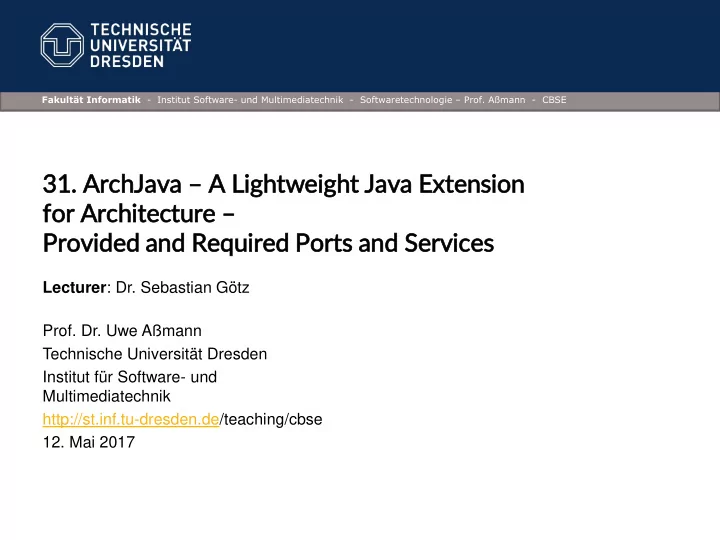

Fakultät Informatik - Institut Software- und Multimediatechnik - Softwaretechnologie – Prof. Aßmann - CBSE 31. . ArchJava – A Lig ightweight Java Ext xtension fo for Archit itecture – Provided and Required Ports and Servic ices Lecturer : Dr. Sebastian Götz Prof. Dr. Uwe Aßmann Technische Universität Dresden Institut für Software- und Multimediatechnik http://st.inf.tu-dresden.de/teaching/cbse 12. Mai 2017
Literature (To Be Read) Component-Based Software Engineering (CBSE) J. Aldrich, G. Chambers, D. Notkin. Architectural Reasoning in ArchJava. ► European Conference on Object-Oriented Programming (ECOOP) 2002, LNCS
The Problem Component-Based Software Engineering (CBSE) An architectural description language needs many constructs that are ► already available in a standard language Control-flow constructs ■ Iteration, Recursion ■ Data types ■ Reasoning is simpler if components and architecture are described in the ► same language (same analysis tools)
Communication Integrity Component-Based Software Engineering (CBSE) Provided and required interfaces enable explicit dependencies between components and communication integrity: Communication integrity: Every implementation component can only communicate with the neighbors that were specified in the interface or the architecture (connection topology) Communication integrity relies on provided and required interfaces.
Ports in ArchJava Component-Based Software Engineering (CBSE) In ArchJava, ports are call services (call ports) of a component class ► Required, provided, broadcast ports ■ public component class Parser { public port pin { Parser provides void setInfo(Token symbol, SymTabEntry e); out in requires Token nextToken() throws ScanException; } public port pout { provides SymTabEntry getInfo(Token t); requires void compile(AST ast); } public void parse() { Token tok = pin.nextToken(); AST ast = parseFile(tok); pout.compile(ast); } AST parseFile(Token lookahead) { ... } void setInfo(Token t, SymTabEntry e) {...} SymTabEntry getInfo(Token t) { ... } ... }
Connections and Subcomponents Component-Based Software Engineering (CBSE) Connections between ports are specified with connect keyword (as in Unicon) ► Broadcast ports are similar to required ports, but can be connected to many recipients ► Nested component hierarchies are possible with nested subcomponents ( final means ► atomic ) public component class Compiler { Nested subcomponents private Scanner scanner = ...; private final Parser parser = ...; also atomic ones private final CodeGen codegen = ...; connect scanner.out, parser.in; connect parser.out, codegen.in; public static void main(String args[]) { new Compiler().compile(args); } public void compile(String args[]) { // for each file in args do: ...parser.parse();... } }
Architecture Modelling Component-Based Software Engineering (CBSE) All object-oriented concepts can be used to model architectures ► Inheritance for sharing features of architectures ■ Abstract and generic classes for architectural frameworks ■ Framework hook technology for frameworks ■ Dynamic architectures with polymorphism, constructors, and abstract factories ■ No connectors are provided by default ► But can be programmed as specific communicating components ► Asynchronous connections must be defined by the user ► By default, only call connections (and broadcasting call connections) are supplied ►
Run-Time, Dynamic Architectures Component-Based Software Engineering (CBSE) WebServer create workers Router Worker request serve public component class WebServer { private final Router r = new Router(); // initial configuration connect r.request, create; // A connection pattern allows for dynamic calls to connect function connect pattern Router.workers, Worker.serve; public void run() { r.listen(); } public port create { provides r.workers requestWorker() { final Worker newWorker = new Worker(); // dynamic connection of new workers with port r.workers r.workers connection = connect (r.workers, newWorker.serve); // connect expressions return connection objects return connection; Port interface type } } }
Experience with ArchJava Component-Based Software Engineering (CBSE) Taprats is a pattern-designing program for islamic tile patterns ► 12.5 KLOC Java ■ Was reengineered with ► 5.5 hours, 30 minutes per KLOC ■ Since ArchJava enforces communication integrity, code had to be reengineered, ■ dependencies must be cut Violations of the Law of Demeter create problems ■ Law of Demeter: “Don't call grandneighbors , only neighbors” ■
What Have We Learned? Component-Based Software Engineering (CBSE) ArchJava is a ready-to-use architectural extension of Java ► Inherits benefits from object-orientation and architectural languages ► Violations of the Law of Demeter create problems ► ArchJava components, ports, and connections can easily be integrated into ► other modular and object-oriented languages
The End Component-Based Software Engineering (CBSE)
Recommend
More recommend